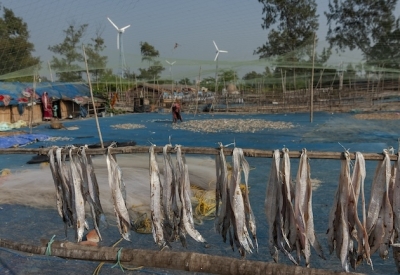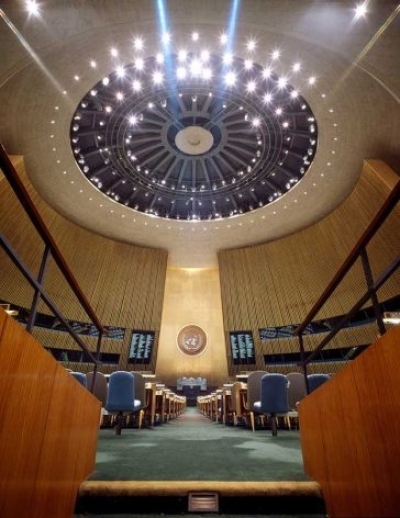STOCKHOLM, Dec 19 (IPS) — The climate is warming up because we are accumulating carbon dioxide in the atmosphere by burning fossil fuels, and all else results from this! So, having a global climate meeting that cannot agree on having this stated in the final statement is like driving your car to the auto mechanics with an engine problem, but instead of getting that fixed, you get a haircut in the front seat to look better. —Professor Michael Tjernström, Stockholm University Conflicting emotions greet the outcomes of COP28. After 28 years of climate conferences, an agreement has, for the first time, proclaimed that fossil fuels are the biggest culprit behind the warming of our planet and stated that it would encourage all nations to “accelerating action in this critical decade so as to achieve net zero by 2050 in keeping with the science." The agreement calls for, among other things, a tripling of renewable energy by 2030, but also an increased pace in the work to develop technical solutions for the separation and storage of carbon dioxide, an extremely expensive and, so far, limited effort.
However, the agreement can unfortunately not be characterised as "decisive.” The text uses the phrase “transition fuels” as a code word for the fossil gas that causes carbon dioxide emissions, warming up Earth’s atmosphere. The draft text went through multiple iterations over the course of the negotiations, and one version, supported by oil and gas-producing nations, dropped a reference to the root cause of climate change entirely. However, an urgent pushback from the USA, EU, and small island countries saw fossil fuels put back in the text at the last minute, even though the final version lacked the concrete term "phaseout," which many nations wanted to see.
Palliative formulations thus give rise to several loopholes, allowing fossil-producing countries to continue with, and even increase, their extraction of harmful fossil fuels. 2023 will be the hottest year on record globally, with extreme weather causing death and destruction in the wake of climate change. To mitigate the worst effects, global emissions must be halved by 2030, but so far, the curves continue to rise. Considering this, it has to be kept in mind that the climate meeting’s agreement is not legally binding but only a signal of a direction forward. It still remains uncertain whether COP28 will really result in the countries of the world advancing from words to action.
On this worrisome note, please read this IPS interview with Michael Tjernström, Professor of Meteorology at Stockholm University.
IPS: What is your opinion about the recently concluded COP 28?
Tjernström: The situation is bizarre. The climate system is one of the most complex issues we have to deal with as a society, even without involving its many interactions with human and social sciences. Accordingly, it is not strange that there are many things we don’t fully understand, but this we do know: The climate is warming up because we are accumulating carbon dioxide in the atmosphere by burning fossil fuels, and all else results from this! So, having a global climate meeting that cannot agree on having this stated in the final statement is like driving your car to the auto mechanics with an engine problem, but instead of getting that fixed, you get a haircut in the front seat to look better.
That being said, this statement is better than nothing, but not by a whole lot. Sometimes I do think that it might have been better if the meeting had crashed and burned. After all, the Paris Agreement came after the Copenhagen fiasco; sometimes we need to fail in order to succeed.
IPS: This spring, you were part of a research team visiting the Arctic Sea onboard the Swedish icebreaker Oden. Why did you travel to the Arctic, and why did you use an icebreaker?
Tjernström: The Arctic is particularly sensitive to climate change. It is usually said that global warming is going twice as fast in the Arctic as in the rest of the world. However, recent studies indicate that the change might be four times as fast on average across the whole Arctic and up to seven or eight times as fast in some places, for example, around Svalbard and in the Russian Arctic Ocean. Despite the Arctic being so vulnerable, there are almost no other places on earth where the climate system is so under-observed. Over the Arctic Ocean, permanent observation stations cannot be established because of the ever-moving and deforming sea ice. Accordingly, it is most convenient to have an icebreaker as a base for observations and research in this hard-to-reach, inhospitable ocean.
IPS: How many members are there on such an expedition, and have you been doing this kind of research before?
Tjernström: This was my fifth expedition with the research icebreaker Oden. There were 75 people onboard, of whom about 40 were researchers, about 20 members of the ship’s regular crew, and 15 logistics staff. The latter two included kitchen staff, a medical doctor and a nurse, a helicopter pilot, a meteorologist and air traffic controller, several technicians, and even an artist. The artist—in this case, a painter—has a historical heritage. Ever since scientific expeditions were organised hundreds of years ago, it was important to have an artist as part of the team. In those days, photographic techniques did not exist, and a painter was necessary for the documentation of the findings. Ever since, it has been customary to have an artist onboard.
IPS: Is it inconvenient to stay on an icebreaker for several months?
Tjernström:. Yes and no; actually, mostly no, but it is a very special experience. We have electricity and heat, good food, a sauna, gym, library, laboratories, and a small movie theatre. Of course, it is sometimes difficult to live so close to others, but we generally have a good and cooperative mood. And we have lots of work to do! This is not a 9-5 job, with weekends free. And even if it was, there’s not much else to do.
IPS: What does your research consist of?
Tjernström: In a general sense, we try to observe the state of the climate system, but we also measure the processes that generate that state. We are, so to speak, taking the pulse of the current situation, though we are also trying to establish tendencies by taking samples and measuring climatological changes. The goal of our research is to improve our climate models, i.e., computer models describing the Earth’s climate system, essentially a virtual synthetic climate that can also be used to indicate future changes or processes. Climate models have some similarities to weather forecast models, but instead of delivering a ten-day weather forecast detailing a nearby development, a climate model provides a “forecast” of climate for maybe one hundred years into the future. The IPCC, a UN climate panel, uses the results from these models, among other things, to calculate the effects of climate change.
The main task of an Arctic expedition is to secure various measurements. We make comparisons between different weather conditions, observe the clouds and the aerosols, take samples to establish the salinity and temperature of the ocean, and examine the occurrence of microorganisms. We also set up measuring stations on the ice and took snow, ice, and water samples. One group drove a remote-controlled mini-submarine under the ice, and another mounted measuring instruments under a helicopter to study variations over larger surfaces. We also released weather balloons to measure atmospheric changes.
My main interest for the latest expedition was to study the effect warm air inflows have on the sea ice and snow cover. Actually, one can say there are only two seasons in the Arctic: either it freezes or it melts. We wanted to study how abrupt the shift from winter to summer can be, so Oden followed weather forecasts indicating where warm air flows were moving in. By measuring and studying the direction of air flows, we could study their effects on cloud formation as well as their impact on ice and the ocean. Such observations are now used to understand how the system works, and ultimately, this lays the foundation for the development of climate models.
IPS: Are climate models reliable?
Tjernström: Yes and no; it depends on the purpose. They are quite reliable for calculating future temperatures, but less reliable for precipitation changes. They are also fairly reliable for global averages, but the smaller the area of interest, the greater the uncertainty. One explanation for when the models work less well is when we lack adequate understanding of something, and that is often in part because we do not have sufficient observations.
Most Arctic measurements generally originate from late summer, in August or September, when there is relatively less sea ice and the ice is melting, making it easier for research vessels to work in the area. This time we came earlier than usual in the Arctic, in May and June, which is the beginning of the melting season, making it possible for us to more carefully investigate the nature and change in the system when the sea ice starts its annual melt.
IPS: When was your first research expedition to the Arctic, and have you noticed any changes since then?
Tjernström: My first trip to the Arctic took place in 2001, also on the research icebreaker Oden. If there is something that has really changed during the twenty years I have been doing this research, it is the nature of the ice. We notice this when we place our expensive instruments on the ice, because it is important to find proper multi-year ice for this. This is ice that has survived at least one melting season, and it is generally more durable. It is now becoming increasingly difficult to find ice that is thick and durable enough. There is also more meltwater on top of the ice, compared to the situation during my first expedition. While it is tragic to see how the ice is disappearing, it is important for me not to let emotions run away but to keep a cool head, to objectively and systematically collect observations, and to make as accurate calculations as possible.
IPS What about the wildlife up there? Did you see polar bears and seals?
Tjernström: We see polar bears on every expedition. Polar bears have an incredibly well-developed sense of smell, and an icebreaker is therefore a bear magnet. They are very curious animals as well as dangerous, and an icebreaker with 70 people onboard has a distinct smell. Anyone who needs it gets weapons training on the way up north, and we always have bear guards posted when we work on the ice. However, Arctic Ocean wildlife is vulnerable because it is based on the presence of sea ice all year. For example, there are seals that live their whole lives on the ice, and now it is constantly getting thinner and scarcer.
The Arctic’s food chains are becoming depleted, industrial fishing has taken a toll on the marine flora, and harmful microplastics, mercury, and man-made toxins are becoming increasingly common in the water. Polar bears are at the top of the food chain and are particularly vulnerable. They live on seals, which live on fish, and so on, all the way down to the microorganisms. And in the Arctic Ocean, there are no other top predators present. Pollution and climate change have an impact on everything.
IPS: Reportedly, due to the rising sea levels, Bangladesh, small island states, and megacities like Shanghai, Bangkok, Jakarta, Tokyo, and New York—which have sizable populations concentrated close to coastal plains or river deltas—are in danger. Is this threat real?
Tjernström: Sorry to say, it is. I am worried that, as an example, huge areas of Bangladesh and many low-lying islands are going to disappear, resulting in the loss of human lives. And this affects a large population around the globe living in coastal areas. As a matter of fact, the threat of melting land ice is, in the long run, even worse than the disappearance of ice in the sea. The melting of ice on land is a larger threat than the disappearance of sea ice. Even if we are able to stop greenhouse gas emissions right now, it will take hundreds of years before the inland ice sheets stop melting.
When land ice melts, the runoff significantly increases the amount of water in the oceans, contributing to global sea level rise. Sea ice, on the other hand, is like the ice cubes in a glass of water: when it melts, it does not directly change the level of water in the glass.
Our entire society needs to adapt to climate change. Our lifestyles need to change, and with increasing variations in rainfall and the fact that sea levels are rising, housing and harbours need to be rebuilt, as well as resilience to food and health crises. In wealthy countries, we cannot continue to throw away food and waste energy as we are currently doing. We live between hope and despair, but we can absolutely not give up and do nothing. We must study what is happening and find solutions. First of all, it is not enough to limit fossil fuel emissions; they must be stopped.
IPS: What made you become a climate scientist?
Tjernström: As with so much else that happens in life, it was actually mostly a coincidence. As a young man, I was drafted into mandatory military service as an army medic, which was not something I wanted to do. I then remembered an amazing lecture on how to make your own weather forecast, taught by my fantastic high school physics teacher. I discovered that one could do the mandatory military service as a meteorologist, so I made up a story that I was going to become a meteorologist by profession, got my orders changed, and ended up in the Air Force as a forecast office. After a while, I became increasingly fascinated by research and development. For a while, I continued to work with meteorology within the military forces, deepened my knowledge, and eventually got a PhD in meteorology at Uppsala University. Since then, I have also served at various universities in Sweden and the USA, and now, when I’m about to retire, I work at Stockholm University.
IPS: You are interested in photography and music. Do you think that art can contribute to an increased awareness of climate change?
Michael Tjernström: Definitely, literature and art, including photography and music, are other ways to describe reality. I believe that a researcher’s role should be combined with that of the populariser. Researchers ought to act as knowledge brokers, mediating between hope and despair. Frequently, I think of my role in this as “painting a picture” for people to understand. And from there, the distance to composing and taking a landscape photograph is not that far. Different but equally important parts of the brain are involved, and in this way, we are no different from environmentally conscious artists. We want to engage people and inspire them with a will to change a threatening existence and strive for a better future. But my main goal in life is to understand—nothing more than that.
IPS UN Bureau Report






